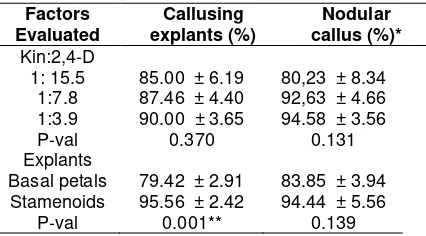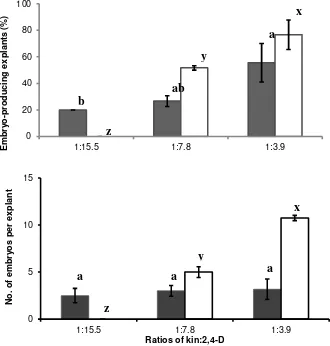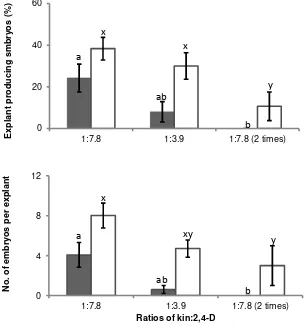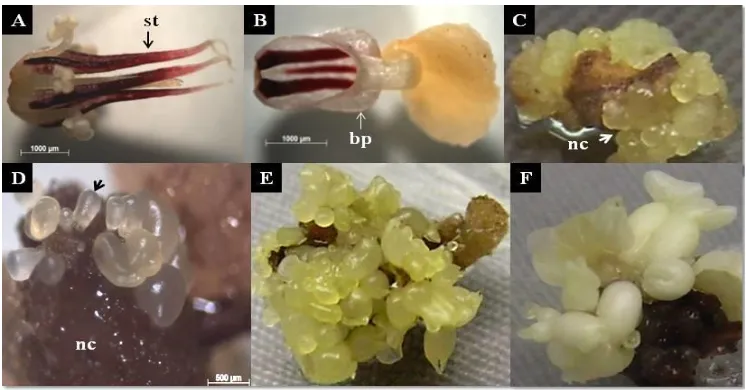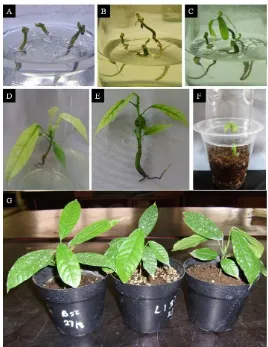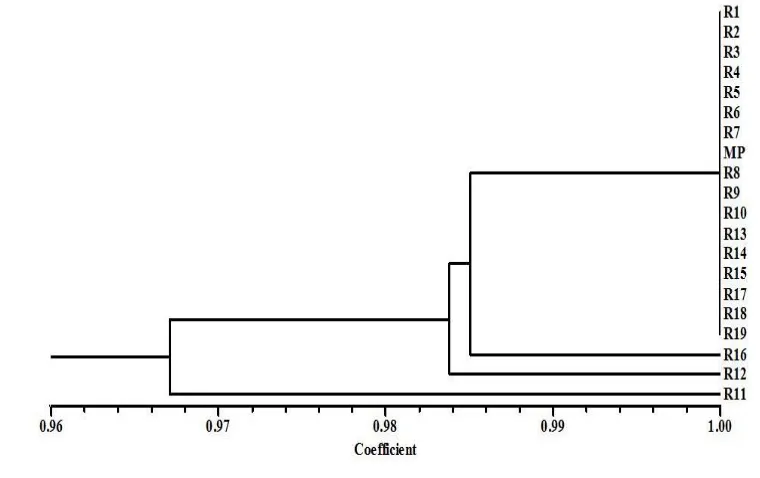EFFECTIVE CACAO SOMATIC EMBRYO REGENERATION ON KINETIN
SUPPLEMENTED DKW MEDIUM AND SOMACLONAL VARIATION
ASSESSMENT USING SSRs MARKERS
Nur Ajijah1, 2*), Rr Sri Hartati3), Rubiyo4), Dewi Sukma1) and Sudarsono1) 1) PMB Lab.,Department of Agronomy and Horticulture, Faculty of Agriculture
Bogor Agricultural University Jl. Meranti Dramaga Campus Bogor 16680 West JavaIndonesia 2) Indonesian Industrial and Beverages Crops Research Institute
Jl. Raya Sukabumi km 2 Parungkuda Sukabumi West Java Indonesia 3) Indonesian Centre for Estate Crop Research and Development
Jl. Tentara Pelajar No. 1 Cimanggu Bogor West JavaIndonesia 4) Assessment Institute for Agricultural Technology Bangka Belitung
Jl. Mentok km 4 Pangkal Pinang 33134, Indonesia *) Corresponding author Email: jijah_ridwan@yahoo.co.id
Received: July 28, 2015/ Accepted: December 7, 2015
ABSTRACT
This study aimed to develop the cacao (Theobroma cacao L.) in vitro regeneration system through somatic embryogenesis on kinetin supplemented DKW medium and somaclonal variation assessment using SSR markers. Callus were initiated from basal petal and staminoid explants cultured on callus induction (CI) medium contained DKW basalt salts and kinetin:2,4-D ratios of 1:15.5, 1:7.8 or 1:3.9 and then transferred onto secondary callus growth (SCG) medium contained WPM basalt salts and kinetin:2,4-D ratios of 1:7.8 or 1:3.9. The calli were then subsequently transferred onto embryo development medium contained DKW basal salts with or without the addition of amino acids, adenine or activated charcoal for the formation of somatic embryos. Nine cacao geno-types were tested for their ability to develop somatic embryos. Results of this study indicated DKW medium supplemented with Kinetin in combination with 2,4-D effectively induced cacao somatic embryogenesis. The highest somatic embryos formation was abtained from kinetin:2,4-D ratio of 1:3.9 and 1:7.8 in CI and SCG medium respectively. Cacao genotype responses were highly explant type dependent. The developed method resulted in a high percentage of somatic embryo formation (5.6-66.7%), germination (50%) and plantlet conversion (65%) and a medium percentage of somaclonal variations based on SSRs marker analysis.
Keywords: explants; genotypes; kinetin:2,4-D; SSRs; Theobroma cacao L.
INTRODUCTION
Cacao (Theobroma cacao L.) is the only plant widely used to produce chocolate. The world cacao demand continues to increase because of the increasing economic growth and public awareness about health benefit of eating chocolate. Cocoa product contains phenols, flavonoids and its antioxidant activity is higher than black tea, green tea or red wine (Subhashini et al., 2010). Eventhough global cacao demand has increased significantly, its production is not and there is a world deficit in cacao supply in recent years (International Cocoa Organization, 2014). Global climate change, pest and disease infestation and reduce plant productivity because of aging have caused world cacao production instability. Stabble cacao production is important for many cacao producing countries to maintain export stability and to ensure supply continuity of industrial raw materials to chocolate industries.
Cacao has an important economic role as a source of foreign exchange in Indonesia. However, the area number of constraints in cacao productionin Indonesia, such as: low yield, pest and disease attack, low bean quality and under develop downstream cacao industries. Recent cacao average productivity in Indonesia reaches 837 kg/ha/year (Indonesian Ministry of Agricul-ture, 2014), which is much lower than the average of expected cacao bean yield potential of 2000 kg Cite this as: Ajijah, N., R.S. Hartati, Rubiyo, D. Sukma and Sudarsono. 2016. Effective cacao somatic embryo regeneration on kinetin supplemented DKW medium and somaclonal variation assessment using SSRs markers. AGRIVITA. 38(1): 80-92. doi: 10.17503/agrivita.v38i1.619
Accredited: SK No.81/DIKTI/Kep/2011
ha-1 year-1. The use of low quality planting materials, inappropriate agronomic technology, pest and plant disease infestation and the plant age are the major contributors to low cacao productivity in Indonesia (Rubiyo and Siswanto, 2012).
In general, seeds or grafted seedlings are used as cacao planting materials. Since cacao is naturally cross-pollinated, cacao planting materials from seeds are usually exhibits a highly heterogeneous genetic background. Therefore, agronomic performance of cacao plantation derived from seeds are highly variable (Li et al., 1998). Cacao planting materials propagated clonally through grafting result in both low multiplication rate and undesirable bushy-like growth pattern. Micropropagation through plant tissue culture is expected to overcome these obstacles.
Cacao breeding usually take a long time and this is because of the long life cycle and the narrow genetic background (Brown et al., 2007). Utilizing plant tissue culture technology and molecular biology is expected to accelerate constrain in achieving cacao breeding programs. In vitro techniques help cacao breeding by generating various genetic variation in a short period of times and in a small space because they are done at the cellular level. Genetic transfor-mation also requires tissue culture technology to regenerate transgenic plants. For those reasons, availability of an efficient in vitro regeneration system of cacao is very important.
Somatic embryogenesis is an efficient in vitro method for regenerating plantlets because it has a high multiplication rate. In vitro plantlet regeneration via somatic embryos has been developed in many plants species, such as coffee (Ibrahim et al., 2012; Ibrahim et al., 2013a; Ibrahim et al., 2013b), soybean (Widoretno et al., 2003a) and one of the rare Indonesian medicinal plants (purwoceng - Pimpinella pruatjan Molk.) (Ajijah et al., 2010). Regeneration methods of cacao through somatic embryo genesis have been developed using thidiazuron (TDZ) (Ajijah et al., 2014). However the success of cacao somatic embryo formation is still low (25 %) and limited to a particular clone (Sca 6). Although TDZ has been reported as effective for inducing cacao somatic embryogenesis (Li et al., 1998), its price is too expensive to most of laboratories in developing countries. Therefore development of an alternative method of cacao somatic embryo
regeneration using less expensive plant growth regulators (PGRs) is needed. The develop somatic embryogenesis method may be used to conduct either clonal propagation of desirable cacao clones, assist in vitro cacao breeding, or cacao genetic transformation.
The objective of this study was to develop an in vitro regeneration system of cacao through somatic embryogenesis using DKW medium supplemented with Kinetin and 2,4-D. Effectiveness of several molar ratios of kinetin to 2,4-D, medium compositions, explants types and genotypes responses on cacao somatic embryogenesis induction was evaluated. The study also estimated the frequency of somaclonal variation among plantlets regenerated from cacao somatic embryos using SSR markers.
MATERIALS AND METHODS
The experiments were carried out at the Tissue Culture Laboratory, Indonesian Agency for Agricultural Research and Development (IAARD) and the molecular analysis was conducted at the Molecular Biology Laboratory of Indonesian Centre for Agricultural Biotechnology and Genetic Resources Research and Development (ICABIO GRAD), Bogor. Closed flower buds of approxi-mately 3 weeks old were collected from field-grown plants at Jampang-Sukabumi, West Java. Flower buds were surface sterilized for 10 min using 5% sodium hypochlorite solution and rinsed tree times with sterile distilled water for 10, 5 and 5 minutes, respectively. Stamenoids (Figure 3A) and basal petals (Figure 3B) were dissected using a sterile scalpel.
Explants were first cultured on callus initiation (CI) medium for 14 d, and then transferred for another 14 d in a modified secondary callus growth (SCG) medium. The CI medium consisted of DKW basal salts supplemented with 9 µM 2,4-D and either 0.58, 1.16 or 2.32 µM kinetin (kin).The molar ratios of those kin:2,4-D were 1.0:15.5, 1.0:7.8 or 1.0:3.9. The modified SCG medium consisted of WPM basal salts supplemented with 9 µM 2,4-D and either 1.16 or 2.32 µM kin.The molar ratios of those kin:2,4-D were 1.0:7.8 or 1.0:3.9. The kin:2,4-D ratio of 1.0:7.8 with 2 times of the standard culture period (2 X 14 d) in SCG medium was also evaluated.
weeks onto same medium until mature cotyle-donary embryos were formed. The ED medium consisted of either DKW basal salts (ED1), DKW + mixture of amino acids (AA) (ED2), DKW + AA + 0.185 µM adenine (ED3), DKW + 0.1% (w/w) activated charcoal (ED4) or WPM basalt salts + AA + 0.185 µM adenine (ED5). The AA consisted of L-arginine (0.435 mg L-1), L-glycine (0.187 mg L-1), L-leucine (0.328 mgL-1), L-lysine (0.456 mg L-1) and tryphtopan (0.510 mg L-1).
Nine cacao genotypes representing Forastero genetic group (Sca 6, Pa 300), Trinitario (UIT 1, ICS 13, GC 7, DR 2, ICCRI 2) and two genotypes of unknown genetic group (Cimanggu 1 and Cimanggu 2) were tested for their somatic embryogenesis responses using the various kin:2,4-D molar ratios of 1.0:3.9 in CI medium and 1.0:7.8 in SCG medium. Embryogenic callus was then transferred onto ED1 medium for the formation and development of somatic embryos.
Data were collected from at least 3 replicates with ten explants per experimental unit. The effects of treatments were determined by analysis of variance (ANOVA) using SPSS 20 statistic software.
SSR Analysis
The DNA was extracted from fresh leaves of 19 plantlets and the mother plant of Cimanggu 2 following the modified protocol for cacao DNA extraction as described by Obando and Manuel (2009). DNA polymorphisms were detected by polymerase chain reaction (PCR) using 20 SSR markers according to Pugh et al. (2004) which the primer sequences were re-designed by Kurniasih et al., (2011). PCR reaction was performed in a volume of 12.5 µl, consisted of 2 µl DNA sample as a template, 6.25 µl of PCR mix, 2.75 µl MQ water and 0.75 µl each of forward and reverse primers. The DNA amplification was performed in a DNA thermocycler, using the following steps: a pre-denaturation step of 3 minutes at 95ºC; 35 cyclesof denaturation for 15 seconds at 95ºC, annealing for 15 seconds at 51 - 62ºC depend on microsatellite loci, and extension at 72ºC for 5 seconds; and a final extension at 72ºC for 10 minutes. PCR products were separated on 8% non-denaturing polyacrylamide gels using vertical
electrophoresis at 80 volt for 150 minutes. Gels were documented using Chemidoc gel system after staining using ethydium bromide. Plantlets showing different SSR allele profiles than the mother plant (“off type”) were reevaluated to make sure that it is variants.
RESULTS AND DISCUSSION
Callus formation occurs 5-7 days after culture and was preceded by swelling explants. Two weeks after culture, all responsive explants have formed callus. Two types of callus were observed in this study, namely non-embryogenic white-compact callus and embryogenic yellowish nodular callus (Figure 3C). Somatic embryos only formed from this nodular callus type.
The level of kin or kin:2,4-D ratiosin CI medium and its interaction with explants types did not significantly affect callus and nodular callus formation while the types of explants did. The average percentage of callus formation from stamenoid was significantly higher compared to that from basal petal (Table 1). Although it was not statistical significantly different, increasing kin level or kin:2,4-D in CI medium increased the callus and nodular callus formation (Table 1).
Table 1. Effect of kin:2,4-D ratios in the CI medium and explants types of Sca 6 clone on percentage of callusing explants and nodular callus formation
Figure 1. Effect of kin:2,4-D ratios in CI medium on induction of somatic embryogenesis from basal petals and stamenoids explants of Sca 6 cacao clone. The same letter(s) for each type of explant indicated the responses was not significantly different according to DMRT (P< 0.05). Bars indicate standard errors (SE) of at least three replicates : stamenoids, : basal petals explants. Kin level or kin:2,4-D ratios in the medium,
explants types and interaction effects among the two factors in CI medium significantly affected the somatic embryo formation. Two types of explant responded differently to a given kin:2,4-D ratios. Stamenoid explant seemed to be more responsive to higher kin:2,4-D ratio than that of basal petal. No somatic embryos were formed from stamenoid explants when kin:2,4-D ratio of 1.0:15.5 was used in the medium. On the other hand, the somatic embryos were formed from basal petals at this kin:2,4-D ratio (Figure 1).
When kin:2,4-D ratios were increased from 1.0:15.5 to 1.0:3.9, the average percentage of explants forming somatic embryo from stamenoids and basal petals and the number of embryos per stamenoid explants increased 76, 2.7 and 10 folds,
respectively. However, increasing the kin:2,4-D ratios did not significantly increase the average number of embryos per basal explant (Figure 1). Different responses of the two explant types are likely due to differences in the endogenous hormone content. Endogenous hormone levels are considered as major factors in determining the cellular response (Feher et al., 2003) and crucial factors in influencing explant embryogenic potential (Jimenez, 2005). The different responses of the two types of cacao explants on somatic embryogenesis have been previously reported (Ajijah et al. 2014). Results from this study showed supplementing kin:2,4-D ratio of 1.0:3.9 in CI medium was the best for inducing somatic embryos from either basal petal or stamenoid explants (Figure 1).
0 20 40 60 80 100
1:15.5 1:7.8 1:3.9
Em
bry
o
-prod
uc
in
g
e
x
pl
a
nts
(%
)
z
y
x
b
ab
a
0 5 10 15
1:15.5 1:7.8 1:3.9
No.
of
e
m
bry
os
pe
r
e
x
pl
a
nt
Ratios of kin:2,4-D
z
y
x
The low kin:2,4-D ratio of 1.0:7.8 in SCG medium was required to increase formation of cacao somatic embryos. The average number explant forming somatic embryo and number of somatic embryos per responsive explant decreased when the kin level or kin:2,4-D ratio in SCG medium was increased from 1.0:7.8 to 1.0:3.9 and the
culture period was extended to 2 X 14 d (Figure 2). There was no interaction effect between kin:2,4-D ratios in SCG medium and explant types. The low kin:2,4-D ratio of 1.0:7.8 for 14 d in SCG medium was enough to induce somatic embryos from either basal petal or stamenoid explants (Figure 2).
Figure 2. Effect of kin:2,4-D ratios and culture period in SCG medium on somatic embryogenesis from stamenoids and basal petals of Sca 6 clone. Same letter(s) for each type of explant were not significantly different according to DMRT (P< 0.05). Bars indicate standard errors (SE) of at least three replicates. : stamenoids, : basal petals.
0 20 40 60
1:7.8 1:3.9 1:7.8 (2 times)
Ex
pl
a
nt
prod
uc
in
g
s
m
bry
os
(%
)
x
b
ab
a
y
x
0 4 8 12
1:7.8 1:3.9 1:7.8 (2 times)
No.
of
e
m
bry
os
pe
r
e
x
pl
a
nt
Ratios of kin:2,4-D
y
xy
x
a
ab
The use DKW medium supplemented with kinetin for inducing cacao somatic embryogenesis has not been reported. The present study found that kinetin in combination with 2,4-D was also effective for inducing cacao somatic embryogenesis using a DKW medium-based protocol. The basal salts formulation affected callus quality in relation to plant regeneration capacity (Al Khayri, 2011) and affected culture response to 2,4-D and kinetin (Dalila et al., 2013). DKW basal salts medium was reported more appropriate for cacao somatic embryogenesis than MS basal salts medium (Li et al., 1998) since it contained higher level of calcium, sulphur and magnesium. Those elements may be crucial for somatic embryogenesis and differentiation of cacao explants (Emile et al., 2010). Kinetin is an aminopurine (adenine) derivative type of cytokinins. Together with auxin, cytokinins have a very important role in plant somatic embryogenesis. Exogenous hormone especially auxin and cytokinin are needed for the activation of somatic cell and for the entry to the division cycle (Pasternak et al,. 2002) and for sustained cell division (Feher et al., 2003). Tang et al. (2000) reported that auxin: cytokinin ratio affect-ted the formation of somatic embryos in three cultivars of sour cherry (Prunus cerasus L.). Auxin:cytokinin ratios also influenced the intensity of embryo formation, germination and conversion of Indian chicory (Cichorium intybus L.) as reported by Abdin and Ilah (2007). Present results showed the
molar ratio of kinetin to 2,4-D also had significant effect on cacao somatic embryogenesis. The high kin:auxin ratio of 1.0:3.9 on CI medium and the low kin:auxin ratio of 1.0:7.8 on the SCG medium gave better results for cacao somatic embryo formation than other ratios.
Nodular embriogenic callus induced from basal petals of Sca 6-1 clone on CI medium supplemented with kin:2,4-D ratio of 1.0:3.9 and SCG medium supplemented with kin:2,4D ratio of 1.0:7.8 were sub cultured on several compositions of embryo development medium. In this study embryo development medium was also used as maturation medium. Results of this study indicated medium composition had significant effect on differentiation of embryogenic cells to form somatic embryos. Selection of the appropriate composition of the basal medium is very important in this phase.
The average percentage of explant forming embryos and number of somatic embryos per explant was higher in DKW medium alone (ED1) than those in DKW medium enriched with amino acids, adenine or activated charcoal (Table 2). The average percentage of explant forming embryos and number of embryos per explant was signify-cantly decreased when WPM medium was used, with or without enrichment with amino acids and adenine (ED5) (Table 2). WPM medium has lower content of all macro and micronutrients than that of DKW medium (da Costa Pinto, 2007).
Table 2. Effect of medium compositions on formation of somatic embryos and number of embryos per explant of Sca 6-1 clone
ED medium Embryo forming explants
(%)
Number of embryos per explants
DKW 23.99 ± 5.25a 1.36 ± 1.09a
DKW + amino acids 21.25 ± 9.73a 1.01 ± 0.41a
DKW + amino acids + 0.185 µM adenine 21.94 ± 6.44a 0.74 ± 0.20a DKW + 0.1% activated charcoal 10.13 ± 4.13ab 0.41 ± 0.19ab WPM + amino acids + 0.185 µM adenine 1.67 ± 1.67b 0.03 ± 0.03b
P-val 0.010 0.023
Figure 3. Formation of primary somatic embryos of Sca 6 clone induced using kinetin. (A) Stamenoids (st) and (B) basal petal (bp) were dissected from cacao flower bud.(C) Formation of embryogenic nodular callus (nc) from basal petal, 4 weeks after culture.(D) Formation of pro-embryo (indicated by black arrow) from the surface of nodular callus, 5 weeks after culture.(E) Stamenoid explant covered with somatic embryos at various development stages, 9 weeks after culture and (F) Various stages of cotyledonary embryos, 12 weeks after culture
Somatic embryos were only formed from the surface of nodular callus type which turn brown after sub-cultured on medium without growth regulators (Figure 3D). Based on the microscope observation approximately 200 µm translucent pro-embryos began to develop after 5 weeks of culture (Figure 3D), or one week after the nodular callus was sub cultured on ED medium. Globular embryo further developed to heart, torpedo and cotyledonary shapes (Figure 3E, 3F). The young somatic embryos were yellowish or white in color (Figure 3E, 3F) and changed to milk white color (sometimes with pink cotyledons) after reaching somatic embryo maturation (Figure 3F). In the culture medium, the embryos developed asynchronously and in the same culture vials contained various stages of somatic embryos development (Figure 3E, 3F).
Genotypes Responses
The nine cacao genotypes tested showed different ability to induce somatic embryogenesis and their responses were explant types dependent. The GC 7, ICCRI 2 and Cimanggu 2 cacao clones showed higher responses of somatic embryo-genesis induction when basal petals were used as explants than that of stamenoids. On the contrary, stamenoid explants of Sca 6, ICS 13 and DR 2 cacao clones showed higher responses of somatic
embryogenesis than that of basal petal (Table 3). Such results indicated that selection of appropriate explants is necessary to obtain somatic embryos from explants originated from different cacao genotype. This study also showed that Sca 6 was the most responsive genotype for somatic embryo regeneration among the nine cacao genotypes tested (Table 3).
Table 3. Differences in somatic embryogenesis response of petal and stamenoid explants of nine cacao genotypes
Genotypes Genetic
Group
Explants producing embryos (%)
No. of embryos per explants
Basal petals Stamenoids Basal petals Stamenoids
Sca 6 Forastero 20.0 ± 2.9abB 66.7 ± 6.7aA 3.0 ± 0.6aB 24.0 ± 2.4aA Pa 300 Forastero 22.0 ± 11.3abA 13.1 ± 2.3bcA 4.3 ± 2.5aB 15.6 ± 2.1bA UIT 1 Trinitario 18.0 ± 3.4abA 26.7 ± 13.7bA 3.2 ± 1.0aA 1.0 ± 0.5cA ICS 13 Trinitario 6.7 ± 3.3bA 22.9 ± 4.0bA 2.7 ± 2.2aB 11.5 ± 4.4bA DR 2 Trinitario 8.3 ± 5.0abA 24.2 ± 3.4bA 0.7 ± 0.5aA 4.3 ± 1.50cA GC 7 Trinitario 5.6 ± 4.4bA 0.0 ± 0.0cA 2.7 ± 2.1aA 0.0 ± 0.0cA ICCRI 2 Trinitario 26.0 ± 3.9aA 0.0 ± 0.0cB 2.7 ± 0.7aA 0.0 ± 0.0cA Cimanggu 1 Unknown 15.0 ± 7.6abA 23.3 ± 5.1bA 2.0 ± 1.0aA 1.7 ± 0.7cA Cimanggu 2 Unknown 19.2 ± 1.8abA 0.0 ± 0.0cB 2.9 ± 1.0aA 0.0 ± 0.0cA
Remarks: The value represent mean ± SE of at least three replicates. For each variable, means in a column with different lower letters and those in a row with different capital letter are significantly different according to DMRT (P< 0.05)
Germination and Conversion
Mature somatic embryos at cotyledonary stage were transferred onto the germination medium consisted of DKW basal salt and amino acids. The germinated cacao somatic embryos were maintained under 25-26℃and 16-h (light) photo period under cool-white tubular fluorescent lights (40W, 220V, Philips) of approximately 1800 lux and sub cultured onto the same medium every month until they form leaves. This procedure resulted in 50% somatic embryo germination and plantlets regeneration (Figure 4A-C). The low rate of somatic embryo conversion into plantlets is still a problem in cacao somatic embryogenesis. In this study the rate of somatic embryo germination reached 50%.
Several factors were associated with successful somatic embryo germination and plantlet conversion, such as: the somatic embryo quality and the carbon source in the germination medium. Result of our study also showed the composition and concentration of basal medium also affected the rate of somatic embryo germination (data not showed).
Hardening
Plantlets with a minimum of three leaves were rinsed thoroughly under tap water to remove residual medium from the plantlets and soaked in a 2% fungicide solution for 15 minutes. Plantlets were transplanted to plastic pots containing sterilized mix of soils, sands and coco pits (1:1:1 v/v). The plastic pots were covered with another transparent plastic pots and maintained in the culture room for acclimatization under cool white tubular fluorescent light at 25-26℃. After 1 month, acclimatized plantlets were transferred to room
temperature (27-29 ℃) and plastic glasses were gradually removed. One month later, plantlets were transplanted to larger plastic pot containing sterilized mix of soil and manure (2:1 v/v). Hardening of the plantlets with survival rate of 65.3% (64/98) when maintained at the temperature of 28-30℃ (Figure 4F-G) was obtained using those procedures.
Somaclonal Variation Assessment
Positive PCR amplification in 19 out of 20 SSR loci were observed using mother plant and plantlets regenerated from cacao somatic embryos of Cimanggu 2. We are unable to obtain the PCR product from mTcCIR 95 locus using DNA of mother plant and plantlets regenerated from cacao somatic embryos of Cimanggu 2. The total of 646 alleles was generated from 19 plantlets regenerated from cacao somatic embryos. Three regenerated plantlets (3/19 – 15.8%) exhibited different SSR alele paterns than the originated mother plant. Four allele polymorphisms were found in those 3 plantlets, indicated there was plantlets carrying more than one mutations. Two types of polymorphisms were observed, such as allele losses and new allele formation. The frequency of observed mutations based on SSR marker analysis was 6.2 X 10-3 (4 out of 646 events). Allele loss (Figure 5) was the most frequent polymorphisms found (3 out of 4 events) among plantlets, followed by new allele formation (1 out of 4 events). Cluster analysis among regenerated plantlets based on 19 SSR loci resulted in 0.97 – 100% level of similarity (Figure 6).
Figure 6. Results of cluster analysis among plantlets regenerated from primary somatic embryos of Cimanggu 2 based on 19 SSRs markers. We used the UPGMA using NTSYSpc version 2.02 to conduct cluster analysis. R1-R19 werethe plantlets of Cimanggu 2 regenerated from somatic embryos and MP was the mother plant (Cimanggu 2).
The observed frequency of somaclonal variation in this study was lower than that reported by previous study (Lopez et al., 2010). Lopez et al. (2010) reported that the frequency of somaclonal variation in cacao primary somatic embryogenesis ranged from 35-50%, depending on the genotypes. Those frequencies of somaclonal variation differences may have been because of the genotype diferences or the PGRs used for inducing cacao somatic embryogenesis. Lopez et al., (2010) used TDZ to induce cacao somatic embryos while in this study used kinetin. According to Bidabadi et al. (2010) and Jose et al., (2012), the types and concentrations of PGRs may have caused different level of somaclonal variations. The regenerated cacao plantlets carrying high frequency of allele losses and multiple mutations found in this study support previous finding reported by Lopez et al. (2010).
Tissue culture induced mutation in plants is known as somaclonal variation. Eventhough somaclonal variation is a potential problem in clo-nal propagation, it has been used to regenerate genetic variation in a number of plants (Yusnita et al., 2010; Yuliasti and Sudarsono, 2011; Widoretno et al., 2003c; Purwati et al., 2007).
According to Larkin and Scowcroft (1981), tissue culture derived planting material is a rich and unexpected source of genetic variations. Somaclonal variation induced by tissue culture process is useful to plant breeding since it can regenerate novel characters that can be identified through in vitro selection (Yuliasti and Sudarsono, 2011; Widoretno et al., 2003c; Widoretno et al., 2002; Purwati et al., 2007; Rahayu et al., 2005).
Cacao plantlet regeneration through somatic embryogenesis can be used as method for cacao clonal propagation. In such case, it is necessary to reduce the frequency of somaclonal variation to below 10%.On the other hand, it can also be used to support in vitro breeding. In the later case, higher percentage of somaclonal variation is more desirable. In various crops, somaclonal variation among somatic embryos has been used to identify drought tolerant (Rahayu and Sudarsono, 2015), quantitative and qualitative (Widoretno et al., 2003b) and diseases resistance variants (Yusnita et al., 2005).
CONCLUSIONS AND SUGGESTION
DKW medium supplemented with Kinetin in combination and 2,4-D effectively induced cacao somatic embryogenesis. Kinetin to 2,4-D at 1.0:3.9 molar ratios in callus induction medium and 1.0:7.8 in secondary callus growth medium showed the best result for inducing somatic embryos from cacao explants. Cacao genotype responses were highly explant dependent. The results of this study provide an alternative method of inducing high rate (5.6-66.7%) cacao primary somatic embryogenesis using 2,4-D and Kinetin with a medium frequency of somaclonal variations (16%)
ACKNOWLEDGMENTS
The authors would like to thank the Centre for Estate Crops Research and Development, Indonesian Agency for Agricultural Research and Development (IAARD) for funding this research through DIPA No. 081-09.2.237291/2012-2015.
REFERENCES
Abdin, M.Z. and A. Ilah. 2007. Plant regeneration through somatic embryogenesis from stem and petiole explants of Indian chicory (Cichorium intybus L.). Indian Journal of Biotechnology, 6(2), 250-255. Retrieved fromhttp://nopr.niscair.res.in/handle/1234 5678 9/5120
Ajijah, N., I. Darwati, Yudiwanti and Roostika. 2010. Effect of temperature incubation on growth and development of Purwoceng (Pimpinella pruatjan Molk.) somatic embryos (in Indonesian). Jurnal Penelitian Pertanian Tanaman Industri, 16(2), 56-63. Retrieved from http://www.ejurnal.litbang. pertanian.go.id/index.php/jptip/article/vie w/2046/1776
Ajijah, N., Sudarsono, Rubiyo, and Dewi Sukma (Eds.). 2012. The utilization of somaclo-nal variation for the improvement of cacao (Theobroma cacao L.) resistance against black pod due to Phytophthora palmivora Butl infection. Proceedings from the Meeting of Experts in Biotechnology. Bogor.
Ajijah, N., Rubiyo and Sudarsono. 2014. Callo-genesis and Somatic EmbryoCallo-genesis of Cacao using Thidiazuron through One Step of Callus Induction (in Indonesian). Jurnal Penelitian Pertanian Tanaman
Industri. 20(4): 179-186. Retrieved from http://www.ejurnal.litbang.pertanian.go.id/ index.php/jptip/article/view/2580/2220 Al-Khayri, J.M. 2011. Basal salt requirements differ
according to culture stage and cultivar in date palm somatic embryogenesis. American Journal of Biochemistry and Biotechnology. 7(1): 32-42. doi: 10.3844/ ajbbsp.2011.32.42
Bidabadi, S.S., S. Meon, Z. Wahab and M. Mahmood. 2010. Study of genetic and phenotypic variability among somaclones induced by BAP and TDZ in micro-propagated shoot tips of banana (Musa spp.) using RAPD markers. Journal of Agricultural Science. 2(3): 49-60. doi: http://dx.doi.org/10.5539/jas.v2n3p49 Brown, J.S., W. Phillips-Mora, E.J. Power, C. Krol
C, C. Cervantes-Martinez, J.C. Motama-yor and R.J. Schnell. 2007. Mapping QTLs for resistance to frosty pod and black pod diseases and horticultural traits in Theobroma cacao L. Crop Science. 47(5): 1851-1858. doi: 10.2135/cropsc i2006.11.0753
da Costa Pinto, G.C.C. 2007. Eucalyptus globulus plant regeneration by somatic embryo-genesis (Unpublished doctoral disser-tation). University of Aveiro, Portugal. Dalila, Z.D., H. Jaafar and A.A. Manaf. 2013.
Effects of 2,4-D and kinetin on callus induction of Barringtonia racemosa leaf and endosperm explants in different types of basal media. Asian Journal of Plant Sciences. 12(1): 21-27. doi: 10.3923/ ajps.2013.21.27
Emile, M., N. Nicolas, I.E. Auguste, S. Abdourahamane and D.N. Omoko-lo.2010. Sulphur depletion altered somatic embryogenesis in Theobroma cacao L. biochemical difference related to sulphur metabolism between embryogenic and non embryogenic calli. African Journal of Biotechnology. 9(35): 5665-5675. doi: 10. 5897/AJB10.565
Feher, A., T.P. Pasternak and D. Dudits. 2003. Transition of somatic plant cells to an embryogenic state. Plant Cell, Tissue and Organ Culture. 74(3): 201-228. doi: 10.10 23/A:1024033216561
arabica coffee (Coffea arabica) (in Indo-nesian). Jurnal Tanaman Industri dan Penyegar. 3(1): 13-22. Retrived from
Ibrahim, M.S.D., Rr.S. Hartati, Rubiyo, A. Purwito and Sudarsono. 2013a. Embryogenic callus induction and regeneration potential of arabica coffee by 2,4-dichlorophe-noxyacetic acid and 6-benzyladenine (in Indonesian). Jurnal Tanaman Industri dan Penyegar. 4(2): 91-98. Retrieved from
Ibrahim, M.S.D., Rr.S. Hartati, Rubiyo, A. Purwito and Sudarsono.2013b . Direct and indirect somatic embryogenesis on arabica coffee (Coffea arabica). Indonesian Journal of Agricultural Science. 14(2): 79-86. Retrieved from http://www.ejurnal.litbang. pertanian.go.id/index.php/ijas/article/view /1413/1194
Indonesian Ministry of Agriculture. 2014. Cocoa Outlook (in Indonesian). Ragunan, Jakarta: Central of Agricultural Data and Information System Printing Office. International Cocoa Organization. 2014. ICCO
quartely bulletin of cocoa statistic XI (1) 2013/2014. Retrieved from http://www.i cco.org/about-us/icco-news/266-august- 2014-quarterly-bulletin-of-cocoa-statis-tics.html
Jimenez, V.M. 2005. Involvement of plant hormones and plant growth regulators on In Vitro somatic embryogenesis. Plant Growth Regulation, 47(2-3), 91-110. doi: 10.1007/s10725-005-3478-x
Jose, J., K. Nimisha, M.A. Anu and P. Nambisan. 2012. Evaluation of somaclonal variation in callus cultures of Jatropha curcas maintained on different hormonal combi-nations using RAPD markers. World Jour-nal of Agricultural Sciences. 8(6):
616-623. doi: 10.5829/idosi.wjas.2012. 8.6. 1644
Kurniasih, S., Rubiyo, A. Setiawan, A. Purwantara and Sudarsono. 2011. Genetic diversity analysis of cacao (Theobroma cacao L.) germplasm based on SSR markers (in Indonesian). Jurnal Penelitian Pertanian Tanaman Industri. 17(4): 156-162. Re-trieved from http://sitp.rpn.co.id/ up-loads/riset/kakao/Jurnal%20Littri%2017% 284%29,%202011%20156-162.pdf Larkin, P.J. and W.R. Scowcroft. 1981.
Soma-clonal variation - a novel source of variability from cell cultures for plant improvement. Theoretical and Applied Genetics. 60(4): 197-214. doi: 10.1007/BF 02342540
Li, Z., A. Traore, S. Maximova and M.J. Guiltinan. 1998. Somatic embryogenesis and plant regeneration from floral explants of cacao (Theobroma cacao L.) using thidiazuron. In Vitro Cellular & Developmental Biology
– Plant. 34(4): 293-299. doi: 10.1007/BF0 2822737
Obando, A. and E. Manuel. 2009. Genetic characterization of Theobroma cacao L. in Nicaragua (Master Thesis). Retrieved from http://urn.fi/URN:NBN:fi:hulib-2015 072 11645
Pasternak, T.P., E. Prinsen, F. Ayaydin, P. Miskolczi, G. Potters, H.A. Van Onckelen, D. Dudits and A. Feher. 2002. The role of auxin, pH, and stress in the activation of embryogenic cell division in leaf protoplast-derived cells of alfalfa. Plant Physiology, 129(4), 1807-1819. doi: http:// dx.doi.org/10.1104/pp.000810
Pugh, T., O. Fouet, A.M. Risterucci, P. Brottier, M. Abouladze, C. Deletrez, B. Courtois, D. Clement, P. Larmande, J.A.K. N’Goran and C. Lanaud. 2004. A new cacao linkage map based on codominant markers: development and integration of 201 new microsatellite markers. Theo-retical and Applied Genetics. 108(6): 1151-1161. doi: 10.1007/s00122-003-1533-4
Rahayu, E.S., E. Guhardja, S. Ilyas and Sudarsono. 2005. Polyethylene glycol (PEG) induced stress conditions in in vitro culture of peanuts (Arachis hypogaea L.) (in Indonesian). Berkala Penelitian Hayati. 11(1), 39-48. Retrieved from http://www. berkalahayati.org/#/journal/89bc7bb1 Rahayu, E.S. and Sudarsono.2015. In-vitro
selection of drought tolerant peanut embryogenic calli on medium containing polyethylene glycol and regeneration of drought tolerant plants. Emirates Journal of Food and Agriculture. 27(6): 475-487. doi: 10.9755/ejfa.2015.04.062
Rodriguez Lopez, C.M., A.C. Wetten and M.J. Wilkinson. 2010. Progressive erosion of genetic and epigenetic variation in callus-derived cocoa (Theobroma cacao) plants. New Phytologist. 186(4): 856-868. doi: 10.1111/j.1469-8137.2010.03242.x Rubiyo and Siswanto. 2012. Improvement and
development production of cocoa in Indonesia (in Indonesian). Jurnal Tanaman Industri dan Penyegar. 3(1), 33-48. Retrieved from http://balittri.litbang. pertanian.go.id/index.php/publikasi/categ Gunalan. 2010. A comparative phyto-chemical analysis of cocoa and green tea. Indian Journal of Science and Tech-nology. 3(2): 188-192. doi: 10.17485/ ijst/2010/v3i2/29676
Tang, H., Z. Ren and G. Krczal. 2000. Somatic embryogenesis and organogenesis from immature embryo cotyledons of three sour cherry cultivars (Prunus cerasus L.). Sci-entia Horticulturae. 83(2): 109-126. doi:10.1016/S0304-4238(99)00073-4 Widoretno, W., E. Guhardja, S. Ilyas and
Sudar-sono. 2002. Effectiveness of polyethylene glycol for evaluating response of soybean at germination stage against drought stress (in Indonesian). Hayati. 9(2): 33-36. Retrieved from http://repository.ipb.ac.id/ bitstream/handle/123456789/24928/Wah yu%20W%20%28SS%29.pdf?sequence =1&isAllowed=y
Widoretno, W., E.L. Arumningtyas and Sudarsono. 2003a. In Vitro methods for inducing somatic embryos of soybean and plantlet regeneration (in Indonesian). Hayati. 10(1): 19-24. Retrieved from http://repo-sitory.ipb.ac.id/bitstream/handle/1234567 89/24941/Wahyu%20Widoretno%20%28 SS%29.pdf?sequence=1&isAllowed=y Widoretno, W., S. Harran and Sudarsono. 2003b.
Variation in qualitative and quantitative characters among somaclones of soybean derived from In Vitro selected somatic embryo (in Indonesian). Hayati. 10(3), 110-117. Retrieved from http://re-pository.ipb.ac.id/bitstream/handle/12345 6789/24822/Sahid%20Harran.pdf?seque nce=1&isAllowed=y
Widoretno, W., R. Megia and Sudarsono. 2003c. Responses of soybean somatic embryos to polyethylene glycol and its uses for In Vitro selection of soybean against drought stress (in Indonesian). Hayati.10(4): 134-139. Retrieved from http://reposi-tory.ipb.ac.id/bitstream/handle/12345678
9/29668/HAY031004wwi2003-4-134139.pdf?sequence=1&isAllowed=y Yuliasti and Sudarsono. 2011. Responses of
soybean mutant lines to aluminium under In Vitro and In Vivo condition. Atom Indonesia. 37(3): 126-132. doi: http://dx. doi.org /10.17146/aij.2011.80
Yusnita, Widodo and Sudarsono. 2005. In vitro selection of peanut somatic embryos on medium containing culture filtrate of sclerotium rolfsii and plantlet regeneration. Hayati Journal of Biosciences. 12(2): 50-56. Retrieved from http://journal.ipb. ac.id/index.php/hayati/article/view/172/39 Yusnita, H. Aswidinnoor, R. Megia, R. Suseno and
